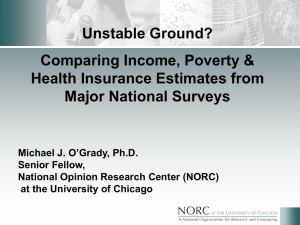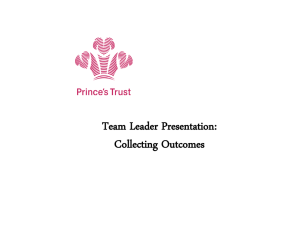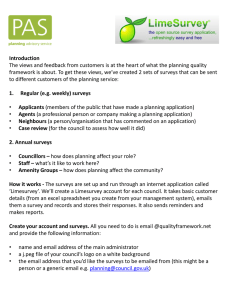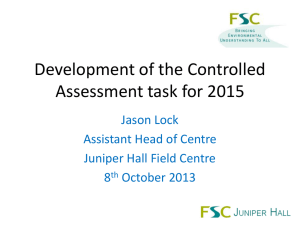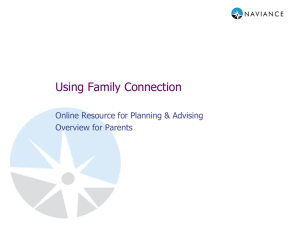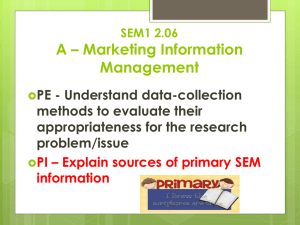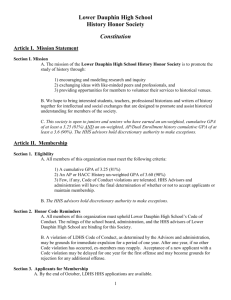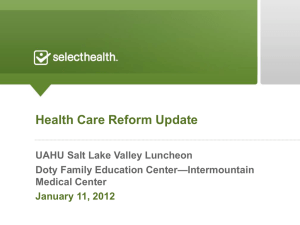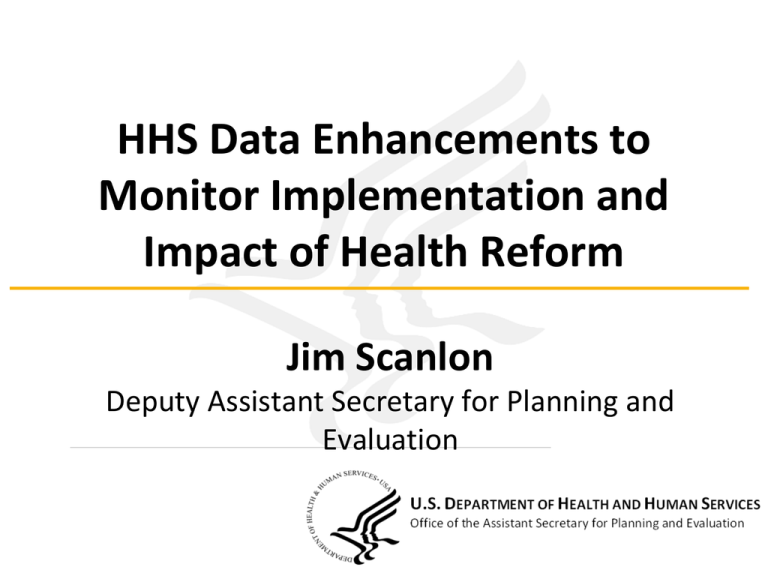
HHS Data Enhancements to
Monitor Implementation and
Impact of Health Reform
Jim Scanlon
Deputy Assistant Secretary for Planning and
Evaluation
Overview
•
•
•
•
Health System Measurement Project
ACA Data Collection Standards
Enhancements to HHS Surveys
Survey Methodology Initiatives
Health System Measurement Project I
• Web Portal
• Indicators in each of ten domains to monitor
implementation &impact of health reform
–
–
–
–
–
Insurance Coverage
Access to Care
Vulnerable Populations
Workforce
Population Health
Health System Measurement Project II
• Indicators in each of ten domains to monitor
implementation &impact of health reform
–
–
–
–
–
–
Quality
Preventive Services
Innovation
Affordability
Health Information Technology Adoption
https://healthmeasures.aspe.hhs.gov/
ACA Data Collection Standards
• ACA Section 4302 requires Secretary to adopt
data collection standards for inclusion in all
HHS health surveys
• Race
• Ethnicity
• Sex
• Primary language
• Disability
ACA Data Collection Standards
• HHS Data Council developed
recommendations
• Public comment
• Adopted by Secretary in October 2011 for
inclusion in all HHS population health surveys
• Based on self reports
• Now being implemented in HHS surveys
• Now considering standards for admin data.
What is your race? (One or more categories may be marked)
– White
– Black or African
American
– American Indian
or Alaska Native
– Asian Indian
– Chinese
– Filipino
– Japanese
– Korean
– Vietnamese
– Other Asian
– Native Hawaiian
– Guamanian or
Chamorro
– Samoan
– Other Pacific
Islander
Ethnicity
• Are you of Hispanic, Latino, or Spanish origin?
(one or more categories may be marked)
–
–
–
–
–
No, not of Hispanic, Latino, or Spanish origin;
Yes, Mexican, Mexican-American, Chicano;
Yes, Puerto Rican;
Yes, Cuban;
Yes, another Hispanic, Latino, or Spanish origin-
Sex
• What is your sex?
– Female
– Male
Primary Language
• Measure of English Proficiency
• How well do you speak English? (5 years of age or
older)
–
–
–
–
Very well
Well
Not well
Not at all
Primary Language
• Measures of spoken language, for additional and
optional granularity:
• Do you speak a language other than English at
home?
– Yes
– No
• If yes, what is this language?
– Spanish
– Other language: ______________
Disability (ACS)
• Are you deaf or do you have serious difficulty hearing?
– Yes
– No
• Are you blind or do you have serious difficulty seeing, even
when wearing glasses?
– Yes
– No
• Because of a physical, mental, or emotional condition, do you
have serious difficulty concentrating, remembering, or
making decisions? (5 years of age or older)
– Yes -- No
Disability
• Do you have serious difficulty walking or climbing stairs? (5 years of age
or older)
– Yes
– No
• Do you have difficulty dressing or bathing? (5 years of age or older)
– Yes
– No
• Because of a physical, mental, or emotional condition, do you have
difficulty doing errands alone such as visiting a doctor's office or
shopping? (15 years old or older)
_ Yes
_ No
Current HHS Data Portfolio
• HHS currently supports a number of major
data collection systems, including
–
–
–
–
Health surveys
Administrative data
Surveillance and research data
Also microsimulation modeling
Surveys and Health Reform
• Portfolio includes household, provider, and
establishment-based surveys
–
–
–
–
Several household surveys are integrated
Certain surveys are linked to Medicare claims data
Some surveys provide state-level data
Certain surveys contain a longitudinal component
Enhancements to Surveys to Monitor
Health Reform
•
•
•
•
•
•
•
Working Group on Data to Monitor Health Reform
Medical Expenditure Panel Survey
National Health Interview Survey
Behavioral Risk Factor Surveillance Survey
National Health Care Survey
CMS Administrative Data
Work with Census Bureau on ACS and CPS
MEPS - HC
• MEPS Household Component
– Already strong platform for measuring
insurance coverage, source, transitions,
utilization and expenditures
– Added questions on high risk pools, health
savings accounts, high deductible health
plan, flexible spending accounts.
MEPS - IC
• MEPS Insurance Component
• Potential additional questions on
–
–
–
–
–
employer plans and offerings
firm size
actuarial value and stop loss policies
wellness programs, and
characteristics of self insured plans and small
employer anticipated exchange participation.
National Health Interview Survey
• Sample size expanded in 2011 to increase the
number of state estimates
• Enhanced questions on access and utilization
of services
• Additional Early Release reports are planned
that will cover 6 months of data using the new
access and utilization questions
NHIS - New Questions
• Changes in coverage for ages 19 to 25
• Coverage of family members living outside the
household & persons living outside household
• Use of primary care physician required by
policy
• Attempts at direct purchase of insurance
• Affordability/Financial burden of medical care
NHIS Additions
•
•
•
•
•
•
•
Awareness of long term care insurance;
Difficulty finding appropriate care when needed;
Emergency department visits;
Why no usual source of care
Use of ACA preventive services;
Using computers for health information, and
Skimping or nonuse of prescriptions drugs due to
cost
BRFSS
• BRFSS is a state-based, on-going telephone
health survey system on health conditions and
risk behaviors in 50 States.
• To help States monitor health reform, new
questions and detail have been added on
– Insurance coverage and source
– Access to care
– Use of preventive services
NAMCS
• Increase in sample will permit State estimates
• Questions added for physicians on
– Average time for patients to obtain an
appointment, time set aside for same day appts,
– EHR adoption
– Is practice currently accepting new patients
– For new patients, types of payment accepted
– Percent of current patients with payment from
Medicaid/CHIP
Collaboration with Census
• Testing of exchange and subsidy questions on
CPS
• ACS health insurance questions
Survey Methodology Initiatives
• NHIS
– Web Panel for quick response data
MEPS
– Quick response telephone survey
– Internet panel
– Extend longitudinal component
NAMCS
– EHR pilot studies
New Data Availability
• Administrative Data
–
–
–
–
Claims data
APCD
Exchange data- enrollment, eligibility, subsidies
Health plan reporting
• Electronic health records data
– HMO Networks
– Public health
Monitoring Health Reform
• Importance of State Level Health Policy Data
• Key Subpopulations Impact Data
– Race and Ethnicity, disabled, rural etc.
• Baseline and progress measures
– Insurance coverage and source
– Transitions into Medicaid/exchanges
– Subsidies
– Access to Care
– Employer behavior
Issues
•
•
•
•
Provider behavior
Plan behavior
Individual and family behavior
Key national indicators – coverage, access,
utilization, expenditures and affordability
Jim Scanlon
Deputy Assistant Secretary for Planning and
Evaluation
U.S. Department of Health and Human Services
Jim.Scanlon@hhs.gov
www.aspe.hhs.gov

